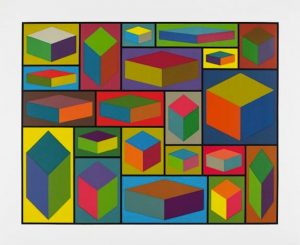
WOW! – Work of the Week – Alex Katz – Laura 1
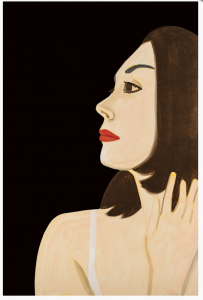
| Alex Katz Laura 1 2017 Archival pigment inks on Crane Museo Max 365 gsm fine art paper 46 x 30 1/2 in. Edition of 100 Pencil signed and numbered |
About the work:
Portraits are one of the great subjects of Alex Katz’s oeuvre. With his signature approach and style, he transforms his circle of family, friends and New York society figures into unforgettable icons. His works are defined by their flatness of color and form, their economy of line, and cool yet seductive emotional detachment.
Katz is the ultimate master of the flat style. His works may appear simple, but rather they are complex studies of color and shading. A student of color theory, he expertly captures depth and dimension with contrasting and complimentary hues like no other artist.
This week’s Work of the Week! WOW! is one of Katz’s most recent portraits, Laura 1. This work is the portrait of Laura Halzack, prima ballerina of the Paul Taylor Dance Company based in New York City. Alex Katz met Laura through Paul Taylor with whom he has collaborated with on over a dozen set and costume designs since 1960.
Laura, as many of Katz’s portrait subjects is presented without context. In the compressed visual plane, she is placed against a background of a single dark hue, which contrasts with the delicate peach tone of her skin. No additional narrative is provided other than her first name. This lack of narrative heightens the enigmatic qualities of the dancer, and allows Laura to exist in and of herself.
Influenced by film, television and billboard advertising, the composition of Laura 1 is like a cinematic close-up. The cropped view of the dancer’s profile is perfectly balanced with the black background. The work is cropped in a way that it seems Katz has captured a sincere, temporal moment, which he indeed has, given the ephemeral nature of dance.
Katz’s distinction as an artist lies in the fascinating reductive, flat style. His mastery of color and minimalism is timeless. His portraits, also have a distinctive quality in that he always represents the society of which he is a part of and, as a whole, can almost be experienced as a family photo album.
WOW! – Work of the Week – Jim Dine – Watercolored by Jim
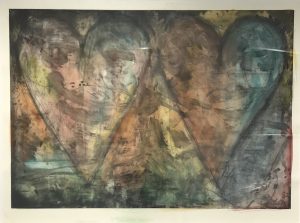
| Jim Dine Watercolored by Jim 2015 Watercolor and copperplate etching 42 x 56 1/2 in. Edition of 6 unique hand-painted pieces Pencil signed, dated, titled and numbered |
About the work:
During the early 1960s, with Pop Art in full swing, one of its earliest champions, Jim Dine, had already moved away from its ideas and was striking out on his own. Marked by a compulsive repetition of subject matter yet tempered with humanity and warmth, the oeuvre that the artist has produced over the last 60 years forms one of the most original bodies of work in 20th- and 21st-century art.
Among his iconic images, hearts are prominently featured. Dine has laid undisputed claim to the simple shape, suggesting boundless possibilities endowed with complex meaning. While repetition was a common motif in Pop Art, Dine employed it to a very different end. Pop was playing with art as mass culture while Dine was imposing a personal, lyrical individualism into his faceless forms. A self-described romantic artist, Dine has embraced the heart as a template through which he could explore relationships of color, texture, and composition. It is a subject of his work that is invested with rich personal significance.
This week’s Work of the Week! WOW! is Watercolored by Jim.
Dine painted his first heart in 1966, developed as a form of self-portraiture while he went through psychoanalytical treatment. The heart-themed works are defined by introspection and emotional vigor, continuously reinvented through the artist’s tactile brushwork, and inventive printmaking techniques. Dine uses the symbolism of the heart for its obvious connection to the strong emotions of love, but also for its values as a geometric framework within which dynamic color relationships and textures can be explored.
The powerful presence of the two hearts in Watercolored by Jim suggests human interaction, the smoky texture is combined with soft fields of watered-down color suggest a complex delicacy. Despite its lightness, it is strong work, as Dine’s expressionist energy is freed from the form. The colors vibrate against one another, fill and bleed beyond the hearts outlines in an organic blending into dense layers.
Dine has a distinct approach to printmaking, it provides him with an opportunity to focus his creative energy on small editions of works that are often experimental in technique and finished by hand. Watercolored by Jim is an edition of 6 unique hand-painted works with watercolor (hence the title) in which only the black lines are printed through copperplate etching.
The work is a tour de force of Dine’s experimentation with innovative monotype and other printmaking techniques. The traditional etching techniques combined with hand-applied details result in this distinctive work that bridges printmaking and painting.
With this painterly work, Dine continues to reinvent the form. The artist’s assertive brushwork is heightened by a soft texture endowing one of his most iconic images with fresh and exciting energy.
WOW! – Work of the Week – Richard Anuszkiewicz – Temple of the Golden Red
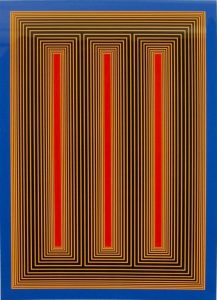
| Richard Anuszkiewicz Temple of the Golden Red 1985 Screenprint 32 x 24 in. Edition of 175 Pencil signed, dated and numbered |
About the work:
“I’m interested in making something romantic out of a very, very mechanistic geometry. Geometry and color represent to me an idealized, classical place that’s very clear and very pure.“ Richard Anuszkiewicz
Richard Anuszkiewicz was a central figure, along with Briget Riley and Victor Vasarely, in the Op Art movement. As a graduate student at Yale, he was mentored by the color theorist Josef Albers who would steer him on a course toward pure abstraction, grounded in the power of color. Most of his work trends away from personal emotion and drama, seeking rather visual investigations of formal structural and color effects. He made extensive use of ‘simultaneous contrast’ – where two colors, side by side, interact with one another to change our perception of them accordingly.
Among his most famed suites is the Temple Series; mesmerizing works, saturated with vibrant color arranged in geometric abstract compositions. The Temple Series originated after a 1981 trip to Egypt. He was inspired by the geometries of sacred temples,specifically those located in the Valley of the Kings. As is characteristic of most of his works, there are no specific references to individual structures, instead he uses the geometric framework as a space of color experimentation. The works in the series have been interpreted as illustrating visionary architect Buckminster Fuller’s notion of ‘Tensegrity’ – the balance between the forces of tension and integrity inherent in a physical structure.
This week’s Work of the Week! WOW! from the Temple Series is Temple of the Golden Red.
Temple of the Golden Red is a quintessential example of Anuszkiewicz’s mature style. Incorporating a repeating pattern of vertically oriented rectangles surrounded by concentric lines of startlingly different color. It contains three central rectangles of saturated crimson surrounded by lines of alternating but as equally saturated yellow and black. Symmetry is essential in Anuszkiewicz’s work, and by juxtaposing opposite colors of equal saturation, he accomplishes a visual fluctuation between figure and ground, creating a vibrating or pulsating sensation in the eye. The result is a release of energy, a transformation of color into motion. Like all great work that depends in large measure on color for its impact, the intensity lays in the way the eye and brain interpret visual information.
As with most artworks, Anuszkiewicz’s work is much more powerful in person. From Temple of the Golden Red emanates a profound luminosity, appearing as if lit from an inner source. New York Times art critic Holland Cotter described Anuszkiewicz’s works by stating, “The drama – and that feels like the right word – is in the subtle chemistry of complementary colors, which makes the geometry glow as if light were leaking out from behind it.” The artwork also packs a powerful monumentality, a result of its architectonic framing that gives the illusion of standing in front of a physical temple. Despite that the work is inspired from a trip to Egypt, the ‘fluting’ can seem to have more in common with classical ancient Greek columns.
Within the boundaries Anuszkiewicz set for himself—vertical bars of color surrounded by the pinstriped framework, the range of effects achieved is remarkable. The colors appear to blaze forth or recede into the distance and the choice of colors projects a mood, in this case, a jazzy up-tempo. Despite the restless optical power of the piece, it is thoroughly classical.
WOW! – Work of the Week – Jasper Johns – Device
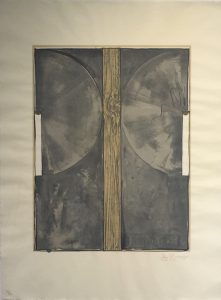
| Jasper Johns Device 1971-72 Lithograph 33 1/2 x 29 in. Edition of 62 Pencil signed, dated and numbered |
About the work:
“I tend to like things that already exist.” Jasper Johns
Jasper Johns is the world’s most critically acclaimed living artist. His work bridges the immediate post-World War II modernist trends of Surrealism and Abstract Expressionism with subsequent movements of Pop art, Minimalism, and Conceptual art.
Johns was ushered into the New York art scene in 1953, when he met Robert Rauschenberg. The two artists shared an intense relationship, both romantic and artistic, from 1954 to 1961. They had neighboring studio spaces and deeply influenced each other’s artwork, exchanging ideas and techniques that would allow them to break from Abstract Expressionism. Their relationship would lead to Johns’ discovery by famed art dealer Leo Castelli, who, while visiting Rauschenberg’s studio met Johns and saw his work. Castelli offered the young Jasper Johns his first solo show on the spot. It was during his first exhibition that Alfred Barr, the founding director of the MoMA, purchased a number pieces that were on display, instantly making Jasper Johns a force in the art world.
Johns’ breakthrough style was to appropriate popular iconography in his works with a rich treatment of the surface as lush and painterly. By representing common objects and images in the realm of fine art, Johns broke down the boundaries traditionally separating fine art and everyday life. However, rather than direct representation or abstraction, Johns made signs, like flags and targets, iconic images in his works. The “things the mind already knows” were his ideal subject because of the varied meanings each carried with it. This would lay the foundation for the Pop art movement’s aesthetic embrace of commodity culture, paving the path for Andy Warhol, James Rosenquist among many, many other post-war artists.
While Johns continued to produce paintings that incorporated Abstract Expressionism’s gestures and color blocking, he shifted his focus from the finished image to the concept behind it. His process, which he believed to be the actual art, took on greater importance. The artist made a seamless transition into print making. For Johns, printmaking was a medium that encouraged experimentation through the ease with which it allowed for repeat endeavors. His innovations in screen printing, lithography, and etching revolutionized the field.
As the Pop art movement grew around him, Johns left behind the colorful works filled with familiar gestures and images and turned to a darker palette. Some critics attribute the shift away from color and toward the grays, blacks, and whites that dominate many of his canvases from the early 1960s to the rocky end of his relationship with Rauschenberg.
This week’s Work of the Week! WOW! is Jasper Johns’ Device.
Created in 1971-72, Device masterfully plays with different tones of grey, white and beige. The works that use what Johns called “the device,” were made from two stretcher bars attached to a canvas frame with butterfly screws, creating a mechanical arm, that would be used to scrape the paint on the surface in a circular shape. All of these elements from the “real” world undercut the traditional idea of a painting as an illusion. The development of the device theme in Johns’ work progressed to incorporate other themes, such as the abundant use of text. His techniques stress conscious control rather than spontaneity.
Over the past fifty years Johns has created a body of rich and complex work. His rigorous attention to the themes of popular imagery and abstraction has set the standards for American art. Constantly challenging the technical possibilities of printmaking, Johns laid the groundwork for a wide range of experimental artists that came after him.
WOW! – Work of the Week – Andy Warhol – The Shadow

| Andy Warhol The Shadow, from Myths (FS II.267) 1981 Screenprint on Lenox Museum Board 38 x 38 in. Edition of 200 Pencil signed and numbered |
About the work:
As a keen observer of the emergence of America as the global superpower it is today, Andy Warhol captured deep American truths and fantasies. “Everybody has their own America, and then they have pieces of a fantasy America that they think is out there but they can’t see,” he once observed. Nowhere is this national fantasy clearer than in Warhol’s Myths Series of 1981.
The suite, composed of 10 iconic representations of recognizable figures of American film, history and culture encompass Warhol’s own life and the magic of 20th century American Pop Culture, or American Mythology. The term ‘Mythology’ (or ‘Myth’) often-times evokes the collected stories of the Ancient Greeks and Romans, however, Mythology is a feature of every culture. The collection of myths of any society defines its spirit and soul.
In the Myths Series, Warhol selected a range of 10 uniquely American personas, from Santa Claus to Uncle Sam, each artwork revealing facets of Warhol’s personality and desires. As a sick child, he was inspired by the duality of Clark Kent/Superman and famously wanted to be regarded as strong an american symbol as Mickey Mouse. Warhol so ardently wanted to be a part of American Mythology that he used his own self-portrait to take on the role of one of the characters in the Myths suite. Overtly self-referential, the artist placed himself among his idols.
This week’s Work of the Week! WOW! is The Shadow, from Myths, in which Andy Warhol used his own face to personify a fictional American icon.
While many of the referenced characters of the suite require no introduction, today ‘The Shadow’ is a more niche symbol of American Pop Culture. ‘The Shadow’ was a fictional pulp-novel character of the 1930’s, a crime-fighting hero of Warhol’s childhood. He wore a wide-brimmed black hat and a black, crimson-lined cloak with an upturned collar over a standard black business suit.
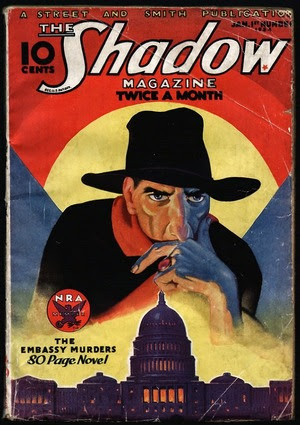 The popular series was also adapted into a Radio Show and a comic strip during Warhol’s lifetime.
The popular series was also adapted into a Radio Show and a comic strip during Warhol’s lifetime.
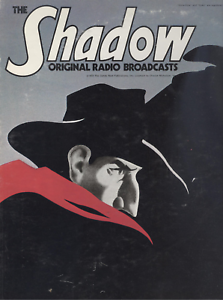 |
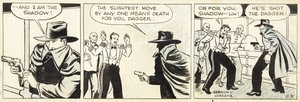 |
The portrait is based on a photograph of Warhol as the fictional character and although he doesn’t wear The Shadow’s black cloak or broad-rimmed hat, the crimson lighting illuminating Warhol’s face, which references the red lining of The Shadow’s cloak, causes a strong shadow to be cast of his profile in the background. While peering at the viewer, Andy Warhol crafts a personification of himself masquerading as a hero.
Andy Warhol exhibited an unerring sense for the powerful motifs of his time – contemporary images that capture the modern imagination as completely as the gods and goddesses of ancient mythology once did. The images presented in Myths are nostalgic representations of America, each theatrically reflecting American fantasies, hopes, fears and dreams. Warhol gives these already established icons his signature pop-style treatment, inserting his own image into the narrative of pop culture.
The Shadow from Myths is a screenprint on Lenox Museum board with Diamond Dust covering the full sheet. The Diamond Dust, heavily applied, adds a luster to the work, but also lends to its mysteriousness, thus accentuating The Shadow. It its a very impressive work.
WOW! – Work of the Week – Frank Stella – Benjamin Moore Series


|
About the work:
Frank Stella is one of the most highly regarded post-war American artists still working today. He is a rule-breaker, interested in furthering the History of Art by constantly and deliberately taking us down new paths.
Upon moving to New York after his studies at Princeton, Stella was first inspired by the Abstract Expressionists, but also by the ‘flat’ works of Barnett Newman. It was however, the paintings of Jasper Johns, exhibited at Leo Castelli’s famed gallery in 1958, that lead Stella to start using his now-trademark stripes as a compositional tool. The controlled minimalist works are among his most recognizable. Stella didn’t change the course of Art History simply through his study and use of a radically different style, he also approached diverse materials in a revolutionary way.
Frank Stella’s first experience in painting was re-coating houses and boats, and he would continue to paint houses after his move to NY to make ends meet. Over the course of his 60-plus-year career, Stella would regularly revisit unmixed house and car paint in addition to using house-painter brushes. Stella’s process was documented in Hollis Frampton’s photo essay “The Secret World of Frank Stella” which showed the artist’s approach to canvas as being the same as he would a house – filling a space with increasingly proximate concentric lines. In his striped works, Frank Stella never used masking tape. He would never even measure out the lines, rather the works are free-hand.
This week’s Work of the Week! WOW! is the Benjamin Moore Series. This series is one of Stella’s most iconic. Andy Warhol recognized the genius of Stella and purchased the complete set of originals himself.
All the titles of Stella’s works are significant. The Benjamin Moore Series makes reference to the type and brand of paint that was used in the creation of the works. The use of store-bought house paints is significant in that it roots his art in the post-war commodity culture. In naming the series after a company, he also explored the rise of advertising and branding. The titles of each individual piece are also important to note – they are all named after historical battles fought during the Civil War.
The two works featured at Gregg Shienbaum Fine Art are Palmito Ranch and Hampton Roads. Both battles were of great significance. The Battle of Hampton Roads, often called either the Battle of the Monitor and Merrimack or the Battle of Ironclads, fought on March 9, 1862, was the most important naval battle of the Civil War from the perspective of naval development. It was History’s first duel between ironclad warships. The Battle of Palmito Ranch is regarded as the final battle of the war, fought May 12 and 13, 1865, on the banks of the Rio Grande in Texas. Despite that Robert Lee had surrendered a month prior to Ulysses Grant, the attack was ordered on the Confederate Army for unknown reasons. Anecdotes suggest that Union Colonel Theodore Barrett wanted to see combat before the end of the war. The names of Stella’s works are significant, loading abstract images with meaning. The complete series is a historical narrative composed of abstract works.
The works in the series are among Stella’s most reductive compositions. It is the formal rather than the thematic matter that Stella engages in. The set plays with maze-like patterns, simple diagonals, and understated and stacked compositions, where the painted line creates an even, horizontal rhythm. Stella shows us the environment of the battles of the Civil War with paint straight from a can – intense and flat. The saturated palette, measured proportions, and glowing presence are at once immediately vibrant and classically timeless.
As Adam D. Weinberg, director of the Whitney has said “Frank is a radical innovator who has, from the beginning, absorbed the lessons of art history and then remade the world on his own artistic terms. He is a singular American master.”
WOW! – Work of the Week – Robert Indiana – Liberty ’76

| Robert Indiana Liberty ’76 1974-75 Screenprint 39 7/8 x 36 in. Edition of 10 Artist Proofs (A.P.) Pencil signed, dated and numbered |
About the work:
“The American dream is that dream of a land in which life should be better and richer and fuller for everyone, with opportunity for each according to ability or achievement.”
– James Truslow Adams, 1931
The July 4th, 1776, American Declaration of Independence proclaims that “all men are created equal” with the right to “life, liberty and the pursuit of happiness.” This founding document, outlining the set of ideals of our nation has been the basis of the national ethos known as The American Dream. This Dream has attracted people from all over the world, lured by the promise of a better way of life, and is deeply rooted in the collective psyche of the American population.
Many artists have been inspired by this great dream, however, Robert Indiana distinguishes himself from his peers through a highly original body of work that explores this American Identity. He addresses important social and political issues, incorporating profound historical and literary references into his works. This is why, in 1974, Stephen Lion, an arts and design consultant, approached Indiana to participate in a tribute portfolio for the 1976 American Bicentennial celebrations. Along with 11 other of his contemporaries such as Alex Katz, Ed Ruscha and Larry Rivers, Indiana would take part in the “Kent Bicentennial Portfolio Spirit of Independence.”
This week’s Work of the Week! WOW! is Robert Indiana’s Liberty ’76 from the Kent portfolio.
A self proclaimed “American painter of signs,” Indiana was introduced to Hard Edge painting by the already well-known painter Ellsworth Kelly. Robert Indiana forged his unique style working with a minimal palette of flat color and using Kelly’s technique of isolating elements from one another. The geometric figures, which, individually seem flat, combined, accomplish great dimension. The placement of each shape is complimented with the use of pure color that gives depth and a sense of motion to his work.
In Liberty ’76, Indiana delivers, through vernacular signage, numbers and symbols a dazzling composition reflecting quintessential Americana in his trademark style. The stars, stripes and a large, red number “76” reference freedom and liberty and pop to the foreground. His bold style can at first glance seem simple, however, this is misleading. He is an underrated and undervalued artistic genius, who created his art with masterful skill and perfection, understanding and manipulating the power of shape and color to create perfectly balanced compositions such as Liberty ’76.
Liberty ’76 perfectly captures the symbolisms of the American Dream and American Identity with a direct and positive outlook. Indiana himself would say: “Pop Art is the American Dream, optimistic, generous and naive!” It is, however, difficult to place Indiana’s body of work into a preset artistic classification because his art transcends and bridges many artistic movements. His work is simultaneously Pop, Hard-Edge, Geometric, Color Field, Textual, Minimalist and Reductive, and therein lies his brilliance. He also provides an example of work that is both deeply personal and universal. His works reflect events of the times while also carrying messages to future generations, adding the element of activism to his oeuvre. He has paved the way for many contemporary artists such as Jenny Holzer and Shepard Fairey, among many others.
Of the 125 Kent Portfolio sets created, 110 were gifted to American museums, 4 to the American Federation of the Arts and 3 to the United States Information Agency. The piece featured at Gregg Shienbaum Fine Art is a rare Artist Proof from a small edition run of 10.
WOW! – Work of the Week – John Baldessari – I Saw It

| John Baldessari I Saw It 1997 Lithograph 17 3/8 x 14 3/8 in. Edition of 100 Pencil signed, dated and numbered |
About the work:
‘Why not give people what they understand most, which is the written word and the photograph.’ John Baldessari
For decades, John Baldessari has pioneered “conceptual art,” an art where it’s the idea that matters over the traditional cannons of aesthetics, techniques and materials. A chief claim of conceptualism is that skill is irrelevant and the idea from the artist’s head becomes art in the mind of the viewers as they try to figure out what they are seeing. The style is accepted as the extreme end of the highly intellectual avant-garde movement, which encompasses Cubism, Dadaism, Surrealism, Abstract Expressionism and Pop.
As one of the most influential artist’s working today, Baldessari has successfully removed his own hand from his works in order to couple text with pre-existing images. His commercial, static style allows the unornamented text and appropriated image to impact the viewer without distraction. Images and texts behave in similar ways, both using formulas to convey their messages. The juxtaposition of both narratives in Baldessari’s work acts as a dual and complimentary means of communication, very similar to the methods used in the press. However, contrary to the press, Baldessari’s unique interplay between two kinds of information is amusing, often creating riddles or jokes.
This week’s Work of the Week! WOW! is I Saw It, which is a prime example of Baldessari’s tongue-in-cheek humor.
In this work, the artist pairs the image of a light fixture with the all caps words “I SAW IT.” The image is not an illustration of the text below it. The text is instead used to make the full range of the image available to the viewer. It is only upon reading the text that the light fixture loses its common identity and function to become a UFO. The humor in Baldessari’s work is a result of the subjection of ordinary everyday objects which take on unexpected meanings and messages.
John Baldessari is able to look beyond what is there, which opens the possibility for others to see things they normally wouldn’t. He avoids “good taste” and allows us to smile, if not laugh, through providing a new context. Just as the best humor is based on the unpredictable, the purpose of art, Baldessari has said, is to keep us “perpetually off-balance.”
Over the course of his career, Baldessari has been challenging audiences to reconsider the nature of art, with wit, humor and a captivating visual sense. And although he has played a crucial role in such major movements as conceptual art and appropriation art, perhaps his greatest contribution is “leveling the playing field,” encouraging viewers to take an active role in the construction of meaning.
WOW! – Work of the Week – Robert Motherwell – Harvest with Blue Bottom

| Robert Motherwell Harvest with Blue Bottom 1973 Lithograph with Collage 36 x 18 in. Edition of 55 Pencil signed and numberedAbout the work: Robert Motherwell is known as one of the most important and influential artists of the 20th century. In 1940, as a promising young painter, he moved from California to New York City, joined a group of artists (including Jackson Pollock, Willem de Kooning, Mark Rothko) and set out to change the face of American art. The artists renounced the prevalent American style, believing Realism depicted only the surface of American life. Motherwell was a key figure in the group to establish America’s first major original art style: Abstract Expressionism, or what he called the New York School, a movement that would place New York at the center of the international art world. Strongly influenced by the European Surrealists, many of whom had emigrated to New York during World War II, the Abstract Expressionists sought to create essential images that revealed emotional truth and authenticity of feeling through the removal of the inessentials and showing only what was necessary. Motherwell who was a fervent admirer of Matisse became a colorist seeking out earthy ochres, brilliant yellows and oranges, blues and violets. He also adopted the Matissian technique of collage, the most radical form of drawing developed in the twentieth century. Motherwell’s collage works were not simply aesthetically pleasing forms and colors, but related to the world in some way. In his collages, he took a personal, lyrical approach, combining fragments of colored paper, labels, letters and stamps in evocative compositions. Incorporating material from his studio such as cigarette packets and labels, the works ultimately became records of his daily life. This week’s Work of the Week! WOW! is Harvest with Blue Bottom, from the Summer Light series, in which Motherwell created elegantly playful collages. The Summer of Light series was made up of some of the most elaborate print-work that Motherwell produced during his career. Each piece was realized using lithography, collage and hand-ripping of different types of paper. Continuing a tradition established by Picasso and Braque of incorporating the detritus of daily life and its simple pleasures, the Summer Light series from 1973 integrates two of Motherwell’s favorite pastimes– drinking and smoking. The title of this image, Harvest with Blue Bottom, derives from the collaged element of the Ernte 23 cigarette label. “Ernte” is the German translation for harvest. The Summer Light series features six images of the Ernte 23 label and four of Château Latour wine labels. Practically, these materials were laying about his studio and were immediate and on hand, but invariably they were autobiographical, serving as a kind of documentation of his daily life and habits. Although he is by no means an ”autobiographical” artist, it’s in his collages that fragments of his life reveal themselves. While viewing a collage retrospective of his in the 1970’s, he was ”astounded that, like Proust eating the madeleine, in these abstract compositions all kinds of personal memories would surface that I’d completely forgotten about – not about painting, but about my daily life, my marriage, where I was living at the time, or who I was particularly friendly with and so on. But the autobiography in them wouldn’t be clear to an outside person.” Beyond autobiographical, the Summer of Light series and all of the artist’s collage work take on the status of the artist’s own diary evoking intimate memories. |
